BepiColombo
 Artist's depiction of the BepiColombo mission, with the Mercury Planetary Orbiter (left) and Mercury Magnetospheric Orbiter (right) | |
| Mission type | Planetary science |
|---|---|
| Operator | |
| COSPAR ID | 2018-080A |
| SATCAT no. | 43653 |
| Mission duration | Cruise: 7 years (planned) Science phase: 1 year (planned) 6 years, 1 month and 1 day (in progress) |
| Spacecraft properties | |
| Manufacturer | |
| Launch mass | 4,100 kg (9,000 lb) [1] |
| BOL mass | MPO: 1,230 kg (2,710 lb) Mio: 255 kg (562 lb) [1] |
| Dry mass | 2,700 kg (6,000 lb) [1] |
| Dimensions | MPO: 2.4 m × 2.2 m × 1.7 m (7 ft 10 in × 7 ft 3 in × 5 ft 7 in) Mio: 1.8 m × 1.1 m (5 ft 11 in × 3 ft 7 in) [1] |
| Power | MPO: 150 watts Mio: 90 watts |
| Start of mission | |
| Launch date | 20 October 2018, 01:45 UTC |
| Rocket | Ariane 5 ECA (VA245)[2] |
| Launch site | Centre Spatial Guyanais, ELA-3[3] |
| Contractor | Arianespace |
| Flyby of Earth (gravity assist) | |
| Closest approach | 10 April 2020, 04:25 UTC |
| Distance | 12,677 km (7,877 mi) |
| Flyby of Venus (gravity assist) | |
| Closest approach | 15 October 2020, 03:58 UTC |
| Distance | 10,720 km (6,660 mi) |
| Flyby of Venus (gravity assist) | |
| Closest approach | 10 August 2021, 13:51 UTC |
| Distance | 552 km (343 mi) |
| Flyby of Mercury (gravity assist) | |
| Closest approach | 1 October 2021, 23:34:41 UTC |
| Distance | 199 km (124 mi) |
| Flyby of Mercury (gravity assist) | |
| Closest approach | 23 June 2022, 09:44 UTC |
| Distance | 200 km (124.3 mi) |
| Flyby of Mercury (gravity assist) | |
| Closest approach | 19 June 2023, 19:34 UTC |
| Distance | 236 km (147 mi) |
| Mercury orbiter | |
| Spacecraft component | Mercury Planetary Orbiter (MPO) |
| Orbital insertion | November 2026 (planned) |
| Orbital parameters | |
| Perihermion altitude | 480 km (300 mi) |
| Apohermion altitude | 1,500 km (930 mi) |
| Inclination | 90,0° |
| Mercury orbiter | |
| Spacecraft component | Mercury Magnetospheric Orbiter (MMO) |
| Orbital insertion | November 2026 (planned) |
| Orbital parameters | |
| Perihermion altitude | 590 km (370 mi) |
| Apohermion altitude | 11,640 km (7,230 mi) |
| Inclination | 90.0° |
 BepiColombo insignia | |
BepiColombo is a joint mission of the European Space Agency (ESA) and the Japan Aerospace Exploration Agency (JAXA) to the planet Mercury.[4] The mission comprises two satellites launched together: the Mercury Planetary Orbiter (MPO) and Mio (Mercury Magnetospheric Orbiter, MMO).[5] The mission will perform a comprehensive study of Mercury, including characterization of its magnetic field, magnetosphere, and both interior and surface structure. It was launched on an Ariane 5[2] rocket on 20 October 2018 at 01:45 UTC, with an arrival at Mercury planned for November 2026, after a flyby of Earth, two flybys of Venus, and six flybys of Mercury.[1][6] The mission was approved in November 2009, after years in proposal and planning as part of the European Space Agency's Horizon 2000+ programme;[7] it is the last mission of the programme to be launched.[8]
On 15 May 2024, ESA reported that a "glitch" prevented the spacecraft's thrusters from operating at full power during a scheduled manoeuvre on 26 April.[9] On 2 September, ESA reported that to compensate for the reduced available thrust, a revised trajectory had been developed that would add 11 months to the cruise, delaying the expected arrival date from 5 December 2025 to November 2026.[10]
Names
[edit]BepiColombo is named after Giuseppe "Bepi" Colombo (1920–1984), a scientist, mathematician and engineer at the University of Padua, Italy, who first proposed the interplanetary gravity assist manoeuvre used by the 1974 Mariner 10 mission, a technique now used frequently by planetary probes.
Mio, the name of the Mercury Magnetospheric Orbiter, was selected from thousands of suggestions by the Japanese public. In Japanese, Mio means a waterway, and according to JAXA, it symbolizes the research and development milestones reached thus far, and wishes for safe travel ahead. JAXA said the spacecraft will travel through the solar wind just like a ship traveling through the ocean.[5] In Chinese and Japanese, Mercury is known as the "water star" (水星) according to wǔxíng.
Following its Earth flyby in April 2020, BepiColombo was briefly mistaken for a near-Earth asteroid, receiving the provisional designation 2020 GL2.[11][12][13][14]
Mission
[edit]The mission involves three components, which will separate into independent spacecraft upon arrival at Mercury.[15]
- Mercury Transfer Module (MTM) for propulsion, built by ESA.
- Mercury Planetary Orbiter (MPO) built by ESA.
- Mercury Magnetospheric Orbiter (MMO) or Mio built by JAXA.
During the launch and cruise phases, these three components are joined together to form the Mercury Cruise System (MCS).
The prime contractor for ESA is Airbus Defence and Space.[16] ESA is responsible for the overall mission, the design, development assembly and test of the propulsion and MPO modules, and the launch. The two orbiters, which are operated by mission controllers based in Darmstadt, Germany, were successfully launched together on 20 October 2018.[17] The launch took place on Ariane flight VA245 from Europe’s Spaceport in Kourou, French Guiana.[18] The spacecraft will have a seven-year interplanetary cruise to Mercury using solar-electric propulsion (ion thrusters) and gravity assists from Earth, Venus and eventual gravity capture at Mercury.[1] ESA's Cebreros, Spain 35-metre (115 ft) ground station is planned to be the primary ground facility for communications during all mission phases.
Expected to arrive in Mercury orbit in November 2026, the Mio and MPO satellites will separate and observe Mercury in collaboration for one year, with a possible one-year extension.[1] The orbiters are equipped with scientific instruments provided by various European countries and Japan. The mission will characterize the solid and liquid iron core (3⁄4 of the planet's radius) and determine the size of each.[19] The mission will also complete gravitational and magnetic field mappings. Russia provided gamma ray and neutron spectrometers to verify the existence of water ice in polar craters that are permanently in shadow from the Sun's rays.
Mercury is too small and hot for its gravity to retain any significant atmosphere over long periods of time, but it has a "tenuous surface-bounded exosphere"[20] containing hydrogen, helium, oxygen, sodium, calcium, potassium and other trace elements. Its exosphere is not stable as atoms are continuously lost and replenished from a variety of sources. The mission will study the exosphere composition and dynamics, including generation and escape.
Objectives
[edit]The main objectives of the mission are:[3][21]
- Study the origin and evolution of a planet close to its parent star
- Study Mercury's form, interior, structure, geology, composition and craters
- Investigate Mercury's exosphere, composition and dynamics, including generation and escape
- Study Mercury's magnetised envelope (magnetosphere) – structure and dynamics
- Investigate the origin of Mercury's magnetic field
- Verify Einstein's theory of general relativity by measuring the parameters gamma and beta of the parameterized post-Newtonian formalism with high accuracy.[22][23]
Design
[edit]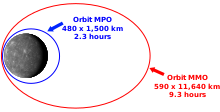
The stacked spacecraft will take eight years to position itself to enter Mercury orbit. During this time it will use solar-electric propulsion and nine gravity assists, flying past the Earth and Moon in April 2020, Venus in 2020 and 2021, and six Mercury flybys between 2021 and 2025.[1]
The stacked spacecraft left Earth with a hyperbolic excess velocity of 3.475 km/s (2.159 mi/s). Initially, the craft was placed in a heliocentric orbit similar to that of Earth. After both the spacecraft and Earth completed one and a half orbits, it returned to Earth to perform a gravity-assist maneuver and is deflected towards Venus. Two consecutive Venus flybys reduce the perihelion near to the Sun–Mercury distance with almost no need for thrust. A sequence of six Mercury flybys will lower the relative velocity to 1.76 km/s (1.09 mi/s). After the fourth Mercury flyby, the craft will be in an orbit similar to that of Mercury and will remain in the general vicinity of Mercury (see [1]). Four final thrust arcs reduce the relative velocity to the point where Mercury will "weakly" capture the spacecraft in November 2026 into polar orbit. Only a small maneuver is needed to bring the craft into an orbit around Mercury with an apocentre of 178,000 kilometres (111,000 mi). The orbiters then separate and will adjust their orbits using chemical thrusters.[24][25]
History
[edit]The BepiColombo mission proposal was selected by ESA in 2000. A request for proposals for the science payload was issued in 2004.[26] In 2007, Astrium was selected as the prime contractor, and Ariane 5 chosen as the launch vehicle.[26] The initial target launch of July 2014 was postponed several times, mostly because of delays on the development of the solar electric propulsion system.[26] The total cost of the mission was estimated in 2017 as US$2 billion.[27]
Schedule
[edit]
BepiColombo · Earth · Venus · Mercury · Sun
For more detailed animation, see this video
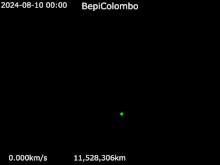
As of 2021[update], the mission schedule is:[1]
| Date | Event | Comment |
|---|---|---|
| 20 October 2018, 01:45 UTC | Launch | |
| 10 April 2020, 04:25 UTC |
Earth flyby | 1.5 years after launch |
| 15 October 2020, 03:58 UTC | First Venus flyby | According to Johannes Benkhoff of ESA, the probe may possibly be capable of detecting phosphine – the chemical allegedly discovered in the Venusian atmosphere in September 2020 – during this and the following flyby. He stated that "we do not know if our instrument is sensitive enough".[28] On 15 October 2020, the ESA reported the flyby was a success.[29] |
| 10 August 2021, 13:51 UTC |
Second Venus flyby | 1.35 Venus years after first Venus flyby. Flyby was a success, and saw BepiColombo come within 552 kilometres (343 mi) of Venus' surface.[30][31] |
| 1 October 2021, 23:34:41 UTC |
First Mercury flyby | Passed 199 kilometres (124 mi) from Mercury's surface.[32] Occurred on what would have been the 101st birthday of Giuseppe Colombo. |
| 23 June 2022, 09:44 UTC |
Second Mercury flyby | 2 orbits (3.00 Mercury years) after 1st Mercury flyby. Closest approach of about 200 kilometres (120 mi) altitude.[33] |
| 19 June 2023, 19:34 UTC |
Third Mercury flyby | >3 orbits (4.12 Mercury years) after 2nd Mercury flyby. Closest approach of about 236 kilometres (147 mi) altitude.[34][35] |
| 4 September 2024, 21:48 UTC | Fourth Mercury flyby | ~4 orbits (5.04 Mercury years) after 3rd Mercury flyby. Closest approach of about 165 kilometres (103mi) altitude.[36] |
| 1 December 2024 | Fifth Mercury flyby | 1 orbit (1.00 Mercury year) after 4th Mercury flyby |
| 8 January 2025 | Sixth Mercury flyby | ~0.43 orbits (0.43 Mercury years) after 5th Mercury flyby |
| November 2026 | Mercury orbit insertion | Spacecraft separation; ~7 Mercury years after 6th Mercury flyby |
| 2027 | MPO in final science orbit | 1.13 Mercury years after orbit insertion? |
| April 2028 | End of nominal mission | 5.82 Mercury years after orbit insertion |
| April 2029 | End of extended mission | 9.98 Mercury years after orbit insertion |

Components
[edit]Mercury Transfer Module
[edit]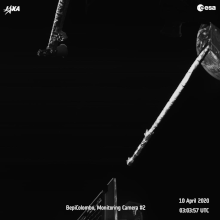
| QinetiQ T6 | Performance [37][38] |
|---|---|
| Type | Kaufman Ion Engine |
| Units on board | 4 [39][40] |
| Diameter | 22 cm (8.7 in) |
| Max. thrust | 145 mN each |
| Specific impulse (Isp) |
4300 seconds |
| Propellant | Xenon |
| Total power | 4628 W |
The Mercury Transfer Module (MTM) has a mass of 2,615 kg (5,765 lb), including 1,400 kg (3,100 lb) of xenon propellant, and is located at the base of the stack. Its role is to carry the two science orbiters to Mercury and to support them during the cruise.
The MTM is equipped with a solar electric propulsion system as the main spacecraft propulsion. Its four QinetiQ-T6 ion thrusters operate singly or in pairs for a maximum combined thrust of 290 mN,[41] making it the most powerful ion engine array ever operated in space. The MTM supplies electrical power for the two hibernating orbiters as well as for its solar electric propulsion system thanks to two 14-metre-long (46 ft) solar panels.[42] Depending on the probe's distance to the Sun, the generated power will range between 7 and 14 kW, each T6 requiring between 2.5 and 4.5 kW according to the desired thrust level.
The solar electric propulsion system has typically very high specific impulse and low thrust. This leads to a flight profile with months-long continuous low-thrust braking phases, interrupted by planetary gravity assists, to gradually reduce the velocity of the spacecraft. Moments before Mercury orbit insertion, the MTM will be jettisoned from the spacecraft stack.[42] After separation from the MTM, the MPO will provide Mio all necessary power and data resources until Mio is delivered to its mission orbit; separation of Mio from MPO will be accomplished by spin-ejection.
Mercury Planetary Orbiter
[edit]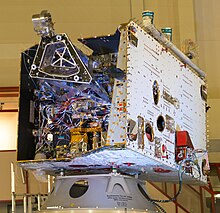

The Mercury Planetary Orbiter (MPO) has a mass of 1,150 kg (2,540 lb) and uses a single-sided solar array capable of providing up to 1000 watts and featuring Optical Solar Reflectors to keep its temperature below 200 °C (392 °F). The solar array requires continuous rotation keeping the Sun at a low incidence angle in order to generate adequate power while at the same time limiting the temperature.[42]
The MPO will carry a payload of 11 instruments, comprising cameras, spectrometers (IR, UV, X-ray, γ-ray, neutron), a radiometer, a laser altimeter, a magnetometer, particle analysers, a Ka-band transponder, and an accelerometer. The payload components are mounted on the nadir side of the spacecraft to achieve low detector temperatures, apart from the MERTIS and PHEBUS spectrometers located directly at the main radiator to provide a better field of view.[42]
A high-temperature-resistant 1.0 m (3 ft 3 in) diameter high-gain antenna is mounted on a short boom on the zenith side of the spacecraft. Communications will be on the X-band and Ka-band with an average bit rate of 50 kbit/s and a total data volume of 1550 Gbit/year. ESA's Cebreros, Spain 35-metre (115 ft) ground station is planned to be the primary ground facility for communications during all mission phases.[42]
Science payload
[edit]
The science payload of the Mercury Planetary Orbiter consists of eleven instruments:[43][44]
- BepiColombo Laser Altimeter (BELA), developed by DLR in cooperation with the University of Bern, the Max Planck Institute for Solar System Research (MPS) and the Instituto de Astrofísica de Andalucía.[45]
- Italian Spring Accelerometer (ISA), developed by Italy
- Mercury Magnetometer (MPO-MAG, MERMAG), developed by Germany and United Kingdom[42]
- Mercury Radiometer and Thermal Infrared Spectrometer (MERTIS), developed by Germany
- Mercury Gamma-ray and Neutron Spectrometer (MGNS), developed by Russia
- Mercury Imaging X-ray Spectrometer (MIXS), developed and built by the University of Leicester, the Max Planck Institute for Solar System Research (MPS) and the Max Planck Institute for Extraterrestrial Physics (MPE).[46][47]
- Mercury Orbiter Radio-science Experiment (MORE), developed by Italy and the United States
- Probing of Hermean Exosphere by Ultraviolet Spectroscopy (PHEBUS), developed by France and Russia
- Search for Exosphere Refilling and Emitted Neutral Abundances (SERENA),[48] made up of 2 neutral and 2 ionised particle analysers:
- ELENA (Emitted Low-Energy Neutral Atoms) developed by Italy;
- STROFIO (STart from a ROtating Field mass spectrOmeter) developed by United States;[49]
- MIPA (Miniature Ion Precipitation Analyser) developed by Sweden;
- PICAM (Planetary Ion CAMera) developed by the Space Research Institute (Institut für Weltraumforschung, IWF), Russian Space Research Institute (IKI), Institut de recherche en sciences de l'environnement (CETP/IPSL), European Space Research and Technology Centre (ESTEC), Research Institute for Particle and Nuclear Physics (KFKI-RMKI) and the Max Planck Institute for Solar System Research (MPS).[45]
- Spectrometers and Imagers for MPO BepiColombo Integrated Observatory System (SIMBIO-SYS), high resolution stereo cameras and a visual and near infrared spectrometer, developed by Italy, France and Switzerland
- Solar Intensity X-ray and Particle Spectrometer (SIXS), developed by Finland and United Kingdom.
Mio (Mercury Magnetospheric Orbiter)
[edit]
Mio, or the Mercury Magnetospheric Orbiter (MMO), developed and built mostly by Japan, has the shape of a short octagonal prism, 180 cm (71 in) long from face to face and 90 cm (35 in) high.[3][50] It has a mass of 285 kg (628 lb), including a 45 kg (99 lb) scientific payload consisting of 5 instrument groups, 4 for plasma and dust measuring run by investigators from Japan, and one magnetometer from Austria.[3][51][52]
Mio will be spin stabilized at 15 rpm with the spin axis perpendicular to the equator of Mercury. It will enter a polar orbit at an altitude of 590 × 11,640 km (370 × 7,230 mi), outside of MPO's orbit.[51] The top and bottom of the octagon act as radiators with louvers for active temperature control. The sides are covered with solar cells which provide 90 watts. Communications with Earth will be through a 0.8 m (2 ft 7 in) diameter X-band phased array high-gain antenna and two medium-gain antennas operating in the X-band. Telemetry will return 160 Gb/year, about 5 kbit/s over the lifetime of the spacecraft, which is expected to be greater than one year. The reaction and control system is based on cold gas thrusters. After its release in Mercury orbit, Mio will be operated by Sagamihara Space Operation Center using Usuda Deep Space Center's 64 m (210 ft) antenna located in Nagano, Japan.[43]
Science payload
[edit]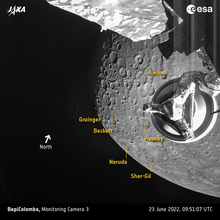
Mio carries five groups of science instruments with a total mass of 45 kg (99 lb):[3][43]
- Mercury Plasma Particle Experiment (MPPE), studies the plasma and neutral particles from the planet, its magnetosphere, and the solar wind. It will employ these instruments:
- Mercury Electron Analyzers (MEA1 and MEA2)
- Mercury Ion Analyzer (MIA)
- Mass Spectrum Analyzer (MSA), developed by Laboratory of Plasma Physics (LPP), Max Planck Institute for Solar System Research (MPS), IDA of Technical University of Braunschweig and Institute of Space and Astronautical Science (ISAS) [53]
- High-Energy Particle instrument for electrons (HEP-ele)
- High-Energy Particle instrument for Ions (HEP-ion)
- Energetic Neutrals Analyzer (ENA)
- Mercury Magnetometer (MMO-MGF), studies Mercury's magnetic field, magnetosphere, and interplanetary solar wind
- Plasma Wave Investigation (PWI), studies the electric field, electromagnetic waves, and radio waves from the magnetosphere and solar wind
- Mercury Sodium Atmosphere Spectral Imager (MSASI), studies the thin sodium atmosphere of Mercury
- Mercury Dust Monitor (MDM), studies dust from the planet and interplanetary space
Mercury Surface Element (cancelled)
[edit]The Mercury Surface Element (MSE) was cancelled in 2003 due to budgetary constraints.[8] At the time of cancellation, MSE was meant to be a small, 44 kg (97 lb), lander designed to operate for about one week on the surface of Mercury.[24] Shaped as a 0.9 m (2 ft 11 in) diameter disc, it was designed to land at a latitude of 85° near the terminator region. Braking manoeuvres would bring the lander to zero velocity at an altitude of 120 m (390 ft) at which point the propulsion unit would be ejected, airbags inflated, and the module would fall to the surface with a maximum impact velocity of 30 m/s (98 ft/s). Scientific data would be stored onboard and relayed via a cross-dipole UHF antenna to either the MPO or Mio. The MSE would have carried a 7 kg (15 lb) payload consisting of an imaging system (a descent camera and a surface camera), a heat flow and physical properties package, an alpha particle X-ray spectrometer, a magnetometer, a seismometer, a soil penetrating device (mole), and a micro-rover.[54]
See also
[edit]- Exploration of Mercury
- MESSENGER – the first spacecraft to orbit Mercury
References
[edit]- ^ a b c d e f g h i "BepiColombo Factsheet". ESA. 6 July 2017. Retrieved 6 July 2017.
- ^ a b "BepiColombo's first image from space". ESA. 10 October 2018.
- ^ a b c d e "MIO/BepiColombo". JAXA. 2018. Retrieved 9 July 2018.
- ^ Amos, Jonathan (18 January 2008). "European probe aims for Mercury". BBC News. Retrieved 21 January 2008.
- ^ a b "MIO – Mercury Magnetospheric Orbiter's New Name" (Press release). JAXA. 8 June 2018. Retrieved 9 June 2018.
- ^ "BepiColombo Launch Rescheduled for October 2018". ESA. 25 November 2016. Retrieved 14 December 2016.
- ^ "BepiColombo Overview". ESA. 5 September 2016. Retrieved 13 March 2017.
- ^ a b "Critical Decisions on Cosmic Vision" (Press release). ESA. 7 November 2003. No. 75-2003. Retrieved 14 December 2016.
- ^ "Glitch on BepiColombo: work ongoing to restore spacecraft to full thrust". ESA. 15 May 2024. Retrieved 29 May 2024.
- ^ "Fourth Mercury flyby begins BepiColombo's new trajectory". ESA. 2 September 2024. Retrieved 2 September 2024.
- ^ "MPEC 2020-G96 : 2020 GL2". Minor Planet Center. 13 April 2020. Archived from the original on 13 April 2020.
- ^ "2020 GL2". Minor Planet Center. 13 April 2020. Archived from the original on 13 April 2020.
- ^ "MPEC 2020-G97 : DELETION OF 2020 GL2". Minor Planet Center. 13 April 2020. Retrieved 14 April 2020.
- ^ "BepiColombo flies by Earth". Europlanet Society. 10 April 2020. Retrieved 24 June 2022.
The data collected for this image, even though it was submitted to the Minor Planet Center as artificial satellite 2018-080A (BepiColombo's official designation), led to it being mistaken for a Near Earth asteroid. The "discovery", announced by the Minor Planet Center as asteroid 2020 GL2, was retracted soon after. This was the third time a spacecraft had been mistakenly announced as a "new asteroid" during an Earth flyby, after Rosetta a.k.a. 2007 VN84 and Gaia a.k.a. 2015 HP116. Incidentally, all three of these are ESA missions.
- ^ Hayakawa, Hajime; Maejima, Hironori (2011). BepiColombo Mercury Magnetospheric Orbiter (MMO) (PDF). 9th IAA Low-Cost Planetary Missions Conference. 21–23 June 2011, Laurel, Maryland. Archived from the original (PDF) on 23 February 2020. Retrieved 15 August 2011.
- ^ "BepiColombo to Enter Implementation Phase". ESA. 26 February 2007.
- ^ Amos, Jonathan (20 October 2018). "Blast-off for BepiColombo on mission to Mercury". BBC News. Retrieved 20 October 2018.
- ^ "Watch BepiColombo launch". European Space Agency. 16 October 2018. Retrieved 8 December 2021.
- ^ Science with BepiColombo ESA, Accessed: 23 October 2018
- ^ Domingue, Deborah L.; Koehn, Patrick L.; et al. (August 2007). "Mercury's Atmosphere: A Surface-Bounded Exosphere". Space Science Reviews. 131 (1–4): 161–186. Bibcode:2007SSRv..131..161D. doi:10.1007/s11214-007-9260-9. S2CID 121301247.
- ^ "BepiColombo: Fact Sheet". ESA. 1 December 2016. Retrieved 13 December 2016.
- ^ "BepiColombo – Testing general relativity". ESA. 4 July 2003. Archived from the original on 7 February 2014. Retrieved 7 February 2014.
- ^ Einstein's general relativity reveals new quirk of Mercury's orbit Emily Conover Science News 11 April 2018
- ^ a b "BepiColombo". National Space Science Data Center. NASA. 26 August 2014. Retrieved 6 April 2015.
 This article incorporates text from this source, which is in the public domain.
This article incorporates text from this source, which is in the public domain.
- ^ "Mission Operations – Getting to Mercury". ESA. Retrieved 7 February 2014.
- ^ a b c BepiColombo: Joint Mission to Mercury Elizabeth Howell Space.com 21 October 2018
- ^ BepiColombo Mercury mission tested for journey into 'pizza oven' Stephen Clarke Spaceflight Now 17 July 2017
- ^ O'Callaghan, Jonathan. "In A Complete Fluke, A European Spacecraft Is About To Fly Past Venus – And Could Look For Signs Of Life". Forbes. Retrieved 16 September 2020.
- ^ "BepiColombo flies by Venus en route to Mercury". ESA. 15 October 2020. Retrieved 15 October 2020.
The flyby itself was very successful", confirms Elsa. "The only difference to normal cruise phase operations is that near to Venus we have to temporarily close the shutter of any of the star trackers that are expected to be blinded by the planet, similar to closing your eyes to avoid looking at the Sun
- ^ "BepiColombo's second Venus flyby in images". European Space Agency. Retrieved 8 December 2021.
- ^ Pultarova, Tereza (11 August 2021). "Mercury-bound spacecraft snaps selfie with Venus in close flyby (photo)". Space.com. Retrieved 8 December 2021.
- ^ ESA Operations [@esaoperations] (2 October 2021). "At 01:34:41 CEST this morning, BepiColombo passed just 199 kilometres (124 mi) from the hot, rocky, innermost planet" (Tweet) – via Twitter.
- ^ "Second helpings of Mercury". European Space Agency. 24 June 2022. Retrieved 24 June 2022.
- ^ "BepiColombo braces for third Mercury flyby". European Space Agency. 14 June 2023. Retrieved 16 June 2023.
- ^ "BepiColombo". Twitter/BepiColombo. 20 June 2023. Retrieved 20 June 2023.
Our #BepiColombo @esaoperations team confirm all went well with our #MercuryFlyby last night! Now we wait and see what images & data our instrument teams collected
- ^ "BepiColombo's best images yet highlight fourth Mercury flyby". www.esa.int. Retrieved 6 September 2024.
- ^ Qualification of the T6 Thruster for BepiColombo Archived 12 August 2016 at the Wayback Machine R. A. Lewis, J. Pérez Luna, N. Coombs. 30th International Symposium on Space Technology and Science 34th International Electric Propulsion Conference and 6th Nano-satellite Symposium, Hyogo-Kobe, Japan, 4–10 July 2015
- ^ QinetiQ's T6 and T5 Ion Thruster Electric Propulsion System Architectures and Performances Archived 15 December 2017 at the Wayback Machine Mark Hutchins, Huw Simpson. 30th International Symposium on Space Technology and Science 34th International Electric Propulsion Conference and 6th Nano-satellite Symposium, Hyogo-Kobe, Japan, 4–10 July 2015
- ^ "T6 ion thruster firing". ESA. 27 April 2016. Retrieved 7 August 2019.
- ^ "T6 ion thrusters installed on BepiColombo". ESA. 26 April 2016. Retrieved 7 August 2019.
- ^ Clark, Stephen D.; Hutchins, Mark S.; et al. (2013). BepiColombo Electric Propulsion Thruster and High Power Electronics Coupling Test Performances. 33rd International Electric Propulsion Conference 6–10 October 2013 Washington, D.C. IEPC-2013-133. Archived from the original on 20 December 2016.
- ^ a b c d e f "Mercury Planetary Orbiter – Spacecraft". ESA. 16 August 2018. Retrieved 7 August 2019.
- ^ a b c "MMO (Mercury Magnetospheric Orbiter): Objectives". JAXA. 2011. Retrieved 7 February 2014.
- ^ "Mercury Planetary Orbiter – Instruments". ESA. 15 January 2008. Retrieved 6 February 2014.
- ^ a b "MPS: BepiColombo – SERENA".
- ^ "MPS: MIXS on BepiColombo".
- ^ Fraser, G.W.; Carpenter, J.D.; Rothery, D.A.; Pearson, J.F.; Martindale, A.; Huovelin, J.; Treis, J.; Anand, M.; Anttila, M.; Ashcroft, M.; Benkoff, J.; Bland, P.; Bowyer, A.; Bradley, A.; Bridges, J.; Brown, C.; Bulloch, C.; Bunce, E.J.; Christensen, U.; Evans, M.; Fairbend, R.; Feasey, M.; Giannini, F.; Hermann, S.; Hesse, M.; Hilchenbach, M.; Jorden, T.; Joy, K.; Kaipiainen, M.; Kitchingman, I.; Lechner, P.; Lutz, G.; Malkki, A.; Muinonen, K.; Näränen, J.; Portin, P.; Prydderch, M.; Juan, J. San; Sclater, E.; Schyns, E.; Stevenson, T.J.; Strüder, L.; Syrjasuo, M.; Talboys, D.; Thomas, P.; Whitford, C.; Whitehead, S. (2010). "The mercury imaging X-ray spectrometer (MIXS) on bepicolombo". Planetary and Space Science. 58 (1–2): 79–95. Bibcode:2010P&SS...58...79F. doi:10.1016/j.pss.2009.05.004. ISSN 0032-0633.
- ^ "SERENA". ESA. Retrieved 7 August 2019.
- ^ "Strofio". Discovery Program. NASA. Archived from the original on 8 January 2017. Retrieved 7 January 2017.
 This article incorporates text from this source, which is in the public domain.
This article incorporates text from this source, which is in the public domain.
- ^ Yamakawa, Hiroshi; Ogawa, Hiroyuki; et al. (January 2004). "Current status of the BepiColombo/MMO spacecraft design". Advances in Space Research. 33 (12): 2133–2141. Bibcode:2004AdSpR..33.2133Y. doi:10.1016/S0273-1177(03)00437-X.
- ^ a b "Mercury Exploration Project "BepiColombo"" (PDF). JAXA. 2014. Retrieved 6 April 2015.
- ^ "A pair of planetary Explorers at Mercury". esa.int. Retrieved 21 October 2018.
- ^ "MPPE".
- ^ "BepiColombo's lander". ESA. 20 February 2002. Retrieved 7 February 2014.
External links
[edit]- BepiColombo website by the European Space Agency
- BepiColombo Operations website by the European Space Agency
- BepiColombo website by JAXA
- BepiColombo website by JAXA's Institute of Space and Astronautical Science
- BepiColombo website by NASA's Solar System Exploration
- BepiColombo website by the National Space Science Data Center
- The BepiColombo mission to Mercury, edited by Johannes Benkhoff, Go Murakami and Ayako Matsuoka. Space Science Reviews. 216–217 (2020–2021)
- BepiColombo article on eoPortal by ESA








